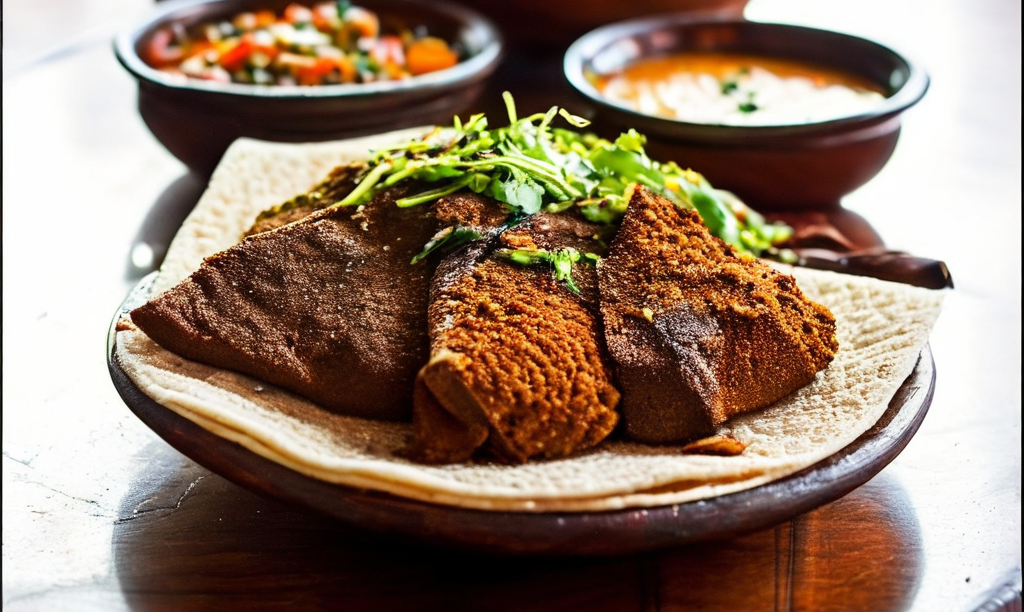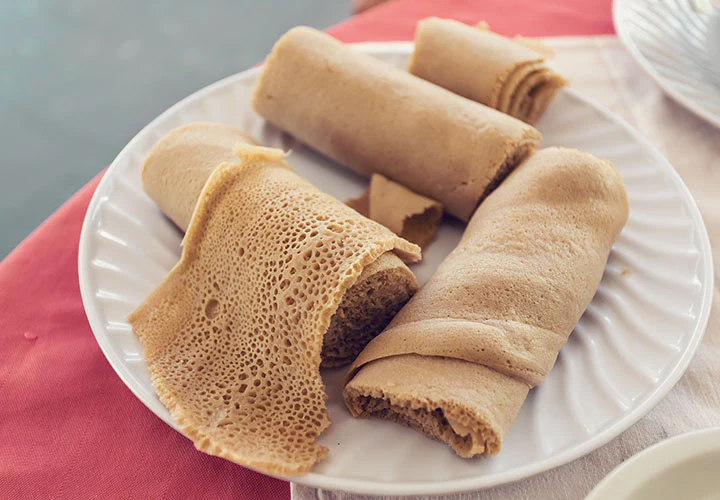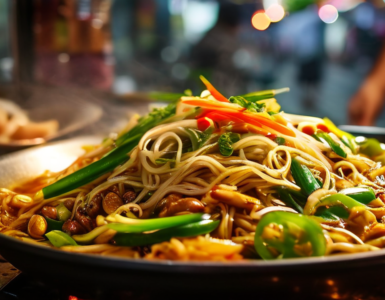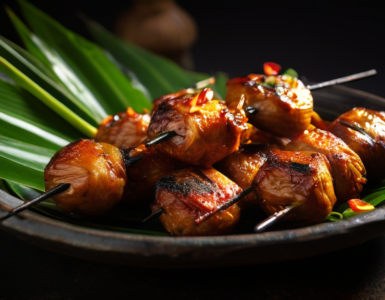Experience the Taste of Ethiopia

Understanding Injera:
Injera is a traditional Ethiopian flatbread that has been enjoyed for centuries across the country and beyond. Made from teff flour, a gluten-free ancient grain native to Ethiopia, Injera is known for its distinctively sour flavor and spongy texture. The batter is fermented for several days, allowing it to develop its characteristic tanginess and bubbles. Injera is typically cooked on a large flat griddle called a mitad or tawa, where it forms a thin, crepe-like pancake with a slightly spongy texture. It’s often served as a base for various Ethiopian dishes such as stews, curries, and salads, or used as a utensil for scooping up food in place of cutlery.
Tips for Success:
1. Start with quality teff flour: Teff flour is the key ingredient in Injera, so it’s important to use high-quality flour for the best results. Look for teff flour that is finely ground and has a dark brown color, which indicates its freshness and richness in flavor.
2. Ferment the batter properly: Fermentation is crucial for developing the characteristic sour flavor and airy texture of Injera. Allow the batter to ferment at room temperature for at least 24-48 hours, or until it becomes bubbly and slightly sour.
3. Use a hot griddle: Cooking Injera requires a hot griddle or skillet to ensure even cooking and the formation of bubbles. Preheat the griddle over medium-high heat before pouring the batter.
4. Pour the batter thinly: Injera should be thin and crepe-like, so pour the batter onto the hot griddle in a thin, even layer. Use the back of a ladle or spoon to spread the batter into a circular shape.
5. Cook until bubbly: Cook the Injera until bubbles form on the surface and the edges start to lift away from the griddle. Avoid flipping the Injera, as it’s traditionally cooked only on one side.
Homemade Injera Recipe:
Ingredients:
- 2 cups teff flour
- 3 cups water
- 1/2 teaspoon salt
- Vegetable oil, for greasing the griddle
Instructions:
1. In a large mixing bowl, combine the teff flour, water, and salt. Stir well to combine, ensuring that there are no lumps in the batter.
2. Cover the bowl with a clean kitchen towel or plastic wrap and let the batter ferment at room temperature for 24-48 hours, or until it becomes bubbly and slightly sour.
3. Once the batter has fermented, preheat a non-stick griddle or skillet over medium-high heat.
4. Lightly grease the surface of the griddle with vegetable oil to prevent the Injera from sticking.
5. Pour a ladleful of the fermented batter onto the hot griddle, spreading it out into a thin, even layer with the back of the ladle or spoon.
6. Cook the Injera for 2-3 minutes, or until bubbles form on the surface and the edges start to lift away from the griddle.
7. Once the Injera is cooked, carefully remove it from the griddle and transfer it to a plate. Repeat the process with the remaining batter, greasing the griddle as needed.
8. Serve the freshly cooked Injera warm alongside your favorite Ethiopian dishes, such as Doro Wat (spicy chicken stew), Misir Wat (red lentil stew), or Atkilt Wat (spiced vegetable stew).
Conclusion:
Congratulations, food vloggers, you’ve just mastered the art of making homemade Injera! With this recipe and our expert tips, you can confidently share the vibrant flavors of Ethiopia with your audience, inspiring them to recreate this beloved flatbread in their own kitchens. So fire up your cameras, gather your ingredients, and get ready to take your viewers on a culinary journey to the heart of Ethiopia with every delicious bite of homemade Injera. Enjoy!
You Might Also Find the Following Articles Intriguing
- Food Vloggers Magazine | Your Ultimate Guide to Food Vlogging
- 20 Best Q&A Questions for YouTube Vloggers 2024 – Different Categories
- Bunny Chow Recipe: South African Dish
- Chapati Recipe: Traditional East African Flatbread
- Ugali Recipe: East African Tradition Dish
- Homemade Fufu Recipe: West African Dish
- Homemade Jollof Rice Recipe: West African Cuisine
- Nyama Choma Recipe: Popular Dish in East African (Kenya, Tanzania, and Uganda)
- Homemade Hamburger Recipe: American Staple Dish
- Homemade Chicken Satay Recipe: Popular Indonesian Dish
- Homemade Ratatouille Recipe: Traditional French Dish
- Homemade Peking Duck Recipe: Chinese Traditional Dish
- Homemade Falafel Recipe: Middle Eastern Traditional Dish
- Homemade Ceviche Recipe: Traditional Dish From Peru
- Homemade Bangers and Mash Recipe: British Staple Dish
- Homemade Ramen Recipe: Noodle Soup Dish Originated in Japan
- Homemade Kebab Recipe: Middle Eastern Special Dish
- Homemade Sushi Burrito Recipe: Special American Dish
- Homemade Hungarian Goulash Recipe: Hungarian Traditional Dish
- Homemade Pho Recipe: Traditional Vietnamese Noodle Soup























































































